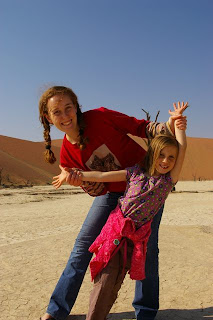We made an early start from Luderitz, leaving behind the Haus Sandrose which had been 'home' for two nights. We'll miss Haus Sandrose because it is the only place where we felt like we had the place to ourselves, and Jean really made us feel at home.
Driving up through the hills between the dunes as we left Luderitz the wind was blowing gusts of sand across the road, and it made the strangest patterns on the road in the early light. It almost looked like water running across the road. Seeing so much sand being moved by the wind it becomes clear why the dune desert is an ever-changing and shifting environment.
After a long stretch across the flats we approached Aus, and once again we took some time to get 'up close and personal' with the desert horses. In the end we had to tear Liesl away because she just wanted to stay with them all day.
After the horses we continued East to Aus, then took a turn through the tiny town, noting some very colorful local hospitality - B&B and Conference facilities, and then we turned south toward Rosh Pinah. Still on tar road - yay! The haul to Rosh Pinah was long, and at stages we could see straight road ahead to the horizon. The mountains of the escarpment rose on our left, and flat plains of grass on our right. Rosh Pinah provided fuel, and nothing more (trust us - you do not want to use the ablutions at that service station), and we proceeded south (now on dirt road) till we met up with the orange river.

Straight road, from here to the horizon, and on...
Then we turned left (East) and for about 50 or 80 km we drove along the banks of the Orange river. This drive was a somewhat surreal experience. The orange river in this area is only about 50 meters above sea level, but the surrounding country is 400 meters and more higher, so the river runs through a valley cut through the mountains of the Richtersveld. These mountains are not pretty. Actually, Janette said they are ugly. They look like piles of ragged rocks discarded by someone who had no use for them. There appears to be almost no life on the rocks, unless you look very carefully. So, while driving along the river, we had steep ragged rock faces rising on our left, the river on our right, sometimes close enough to touch, and then mountains rising up from the other side of the river again. Occasionally there are slightly flat bits in the bottom of the valley, and these host Namaqua daisies, dung beetles, and other odd bits of life. The drive along this route was recommended to us by a few people, who said it is extremely beautiful. I would find it hard to describe the scenery as beautiful, rather as rugged, out-of-this-world, and extreme. But definitely something you MUST see yourself.

"Ugly" mountains in the Richtersveld

In the odd flat space there are splashes of color

Driving between the rocks and a wet place
Later we turned left again heading North toward the Fish River canyon. We wanted to have a peak at Ai-Ais, but you have to pay to enter the resort, so we continued North to the Hobas reserve where the Fish River Canyon hike starts. we went to a few view points there. The Fish River canyon is second only to the Grand Canyon in its size (AFAIK). The views are amazing. I have a new respect for the people who have done the hike - 5 days in the bottom of a desert canyon - rather you than me! Clinton has now decided he WILL do the hike, and he decided Curtis is going with him.

The whole gang at the Fish river canyon
We then moved on to the Canyon Roadhouse to spend the night. The Roadhouse is decorated around a theme of old cars, and they have really taken it to the extreme. But we all agreed it is well done, and it is interesting to see all the old car-memorabilia around the place. Special note - when you use the rest rooms here, please control your curiosity! (Anyone who has been there will know what I mean!)

The Canyon Roadhouse in the evening, soon after we checked in

Novel fireplace in the dining room


















































